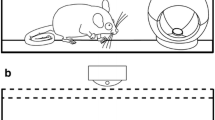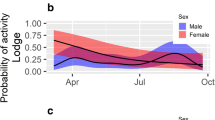Abstract
Many small desert dasyurids employ torpor almost daily during winter, because cold nights and low food availability impose high energetic costs. However, in Western Australia the arid zone extends into tropical, coastal regions, where winter temperature conditions are far less severe. We studied the thermal biology and activity patterns of free-ranging kaluta (~27 g), a dasyurid restricted to these tropical spinifex deserts, during the Austral winter (June–July) and in addition quantified activity patterns in captivity. Unlike most dasyurids, wild and captive kalutas were almost exclusively diurnal and retreated into underground burrows during the night. Despite being active during the warmer part of the day, kalutas entered torpor daily. However, torpor patterns differed remarkably between males and females. While females spent most of the night torpid at body temperatures (T b) as low as 21°C, close to soil temperature, males entered multiple short and shallow bouts (T b > 25°C) during the night. Males also maintained higher T bs during the early morning when active, occupied larger home ranges and covered greater distances while foraging than females. Hence, males appear to expend more energy than the similar-sized females both while foraging and during the rest phase. We propose that physiological as well as behavioural preparations for the September mating season that culminate in a complete male die-off might already impose energetic costs on males during winter.








Similar content being viewed by others
References
Audet D, Thomas DW (1997) Facultative hypothermia as a thermoregulatory strategy in the phyllostomid bats, Carollia perspicillata and Sturnira lilium. J Comp Physiol B 167:146–152
Bartels W, Law BS, Geiser F (1998) Daily torpor and energetics in a tropical mammal, the northern blossom-bat Macroglossus minimus (Megachiroptera). J Comp Physiol B 168:233–239
Bonaccorso FJ, McNab BK (1997) Plasticity of energetics in blossom bats (Pteropodidae): impact of distribution. J Mammal 78:1073–1088
Croft DB (2003) Behaviour of carnivorous marsupials. In: Jones M, Dickman CR, Archer M (eds) Predators with pouches: the biology of carnivorous marsupials. CSIRO Publishing, Collingwood, pp 332–346
Dausmann KH (2008) Hypometabolism in primates: torpor and hibernation. In: Lovegrove GB, McKechnie AE (eds) Hypometabolism in animals. University of KwaZulu-Natal, Pietermaritzburg, pp 327–336
Dickman CR (2003) Distributional ecology of dasyurid marsupials. In: Jones M, Dickman CR, Archer M (eds) Predators with pouches: the biology of carnivorous marsupials. CSIRO Publishing, Collingwood, pp 318–331
Geiser F (1988) Daily torpor and thermoregulation in Antechinus (Marsupialia): influence of body mass, season, development, reproduction, and sex. Oecologia 77:395–399
Geiser F, Drury RL (2003) Radiant heat affects thermoregulation and energy expenditure during rewarming from torpor. J Comp Physiol B 173:55–60
Geiser F, Körtner G (2009) Hibernation and daily torpor in Australian mammals. Aust Zool (in press)
Geiser F, Masters P (1994) Torpor in relation to reproduction in the mulgara, Dasycercus cristicauda (Dasyuridae: Marsupialia). J Therm Biol 19:33–40
Geiser F, Pavey CR (2007) Basking and torpor in a rock-dwelling desert marsupial: survival strategies in a resource-poor environment. J Comp Physiol B 177:885–892
Geiser F, Drury RL, Körtner G, Turbill C, Pavey CR, Brigham RM (2004) Passive rewarming from torpor in mammals and birds: energetic, ecological and evolutionary implications. In: Barnes BM, Carey HV (eds) Life in the cold: evolution, mechanisms, adaptations and applications. Institute of Arctic Biology, University of Alaska, Fairbanks, pp 51–62
Holm E, Edney EB (1973) Daily activity of Namib Desert arthropods in relation to climate. Ecology 54:45–56
Hooge PN, Eichenlaub B (1997) Animal movement extension to Arcview. Ver. 1.1. Alaska Science Center, Biological Science Office, U.S. Geological Survey, Anchorage, AK, USA
Kelt DA, Van Vuren DH (2001) The ecology and macroecology of mammalian home range area. Am Nat 157:637–645
Körtner G, Geiser F (1995) Body temperature rhythms and activity in reproductive Antechinus (Marsupialia). Physiol Behav 58:31–36
Körtner G, Geiser F (2000) Torpor and activity patterns in free-ranging sugar gliders Petaurus breviceps (Marsupialia). Oecologia 123:350–357
Körtner G, Geiser F (2009) The key to winter survival: daily torpor in an arid-zone marsupial. Naturwissenschaften 96:525–530
Körtner G, Pavey CR, Geiser F (2007) Spatial ecology of the mulgara (Marsupialia: Dasyuridae) in arid Australia: impact of fire history on home range size and burrow use. J Zool (Lond) 273:350–357
Körtner G, Pavey CR, Geiser F (2008) Thermal biology, torpor, and activity in free-living mulgaras in arid zone Australia during the winter reproductive season. Physiol Biochem Zool 81:442–451
Lovegrove BG, Génin F (2008) Torpor and hibernation in a basal placental mammal, the lesser hedgehog tenrec Echinops telfairi. J Comp Physiol B 178:691–698
Lovegrove BG, Körtner G, Geiser F (1999) The energetic cost of arousal from torpor in the marsupial (Sminthopsis macroura): benefit of summer ambient temperature cycles. J Comp Physiol B 169:11–18
MacMillen RE, Nelson JE (1969) Bioenergetics and body size in dasyurid marsupials. Am J Physiol 217:1246–1251
Menkhorst P, Knight F (2001) A field guide to the mammals of Australia. Oxford University Press, New York
Morton SR (1978) Torpor and nest-sharing in free-living Sminthopsis crassicaudata (Marsupialia) and Mus musculus (Rodentia). J Mammal 59:569–575
Nicol SC, Andersen NA (2007) Cooling rates and body temperature regulation of hibernating echidnas (Tachyglossus aculeatus). J Exp Biol 210:586–592
Turbill C, Körtner G, Geiser F (2003) Natural use of heterothermy by a small, tree-roosting bat during summer. Physiol Biochem Zool 76:868–876
Tyndale-Biscoe H, Renfree M (1987) Reproductive physiology of marsupials. Cambridge University Press, Cambridge
Vaughan TA (1986) Mammalogy. CBS College Publishing, New York
Warnecke L, Geiser F (2009) Basking behaviour and torpor use in free-ranging Planigale gilesi. Aust J Zool 57:373–375
Warnecke L, Turner JM, Geiser F (2008) Torpor and basking in a small arid zone marsupial. Naturwissenschaften 95:73–78
Withers PC, Cooper CE (2009) Thermal, metabolic, and hygric physiology of the little red kaluta, Dasykaluta rosamondae (Dasyuromorphia: Dasyuridae). J Mammal 90:752–760
Woolley PA (1991) Reproduction in Dasykaluta rosamondae (Marsupilia: Dasyuridae): field and laboratory observations. Aust J Zool 39:549–568
Acknowledgments
The study was conducted under permits form the Western Australian Department of Environment and Conservation and University of New England (UNE) Animal Ethics Committee. The study was supported by the Australian Research Council. Christine Cooper and Phil Withers helped with some of the radio-tracking and also provided the captive kalutas. Alexander Riek assisted with SAS based statistical procedures.
Author information
Authors and Affiliations
Corresponding author
Additional information
Communicated by I. D. Hume.
Rights and permissions
About this article
Cite this article
Körtner, G., Rojas, A.D. & Geiser, F. Thermal biology, torpor use and activity patterns of a small diurnal marsupial from a tropical desert: sexual differences. J Comp Physiol B 180, 869–876 (2010). https://doi.org/10.1007/s00360-010-0459-9
Received:
Revised:
Accepted:
Published:
Issue Date:
DOI: https://doi.org/10.1007/s00360-010-0459-9




